Groundwater Characterization by Means of Conservative (δ18O and δ2H) and Non-Conservative (87Sr/86Sr) Isotopic Values: The Classical Karst Region Aquifer Case (Italy–Slovenia)
Abstract
:1. Introduction
2. The Study Area: Geological, Structural, Geomorphological and Hydrogeological Setting
- (1)
- The effective infiltrations (karst waters) contribute to the recharge with 20.6 m3/s [24].
- (2)
- The Soča/Isonzo springs originate under the glaciated mountains of the Julian Alps in Slovenia. The waters cross the Italian border after 96 km and flow into the Adriatic Sea. It is the second largest river of the Friuli Venezia Giulia Region. Its average discharge, 5 km inland from the Adriatic Sea, is 134 m3/s [56]. The porous aquifer of the Isonzo/Soča and Vipacco/Vipava alluvial plain provides a further substantial but more diffuse recharge estimated in 10 m3/s [26,29,36,37,44,57,58,59,60].
- (3)
- The Reka River flows on the surface for approximately half part of its course on flysch lithologies (31 km calculated on a hypothetic straight path), from Snežnik Mountain (Slovenian-Croatian border area) to the larger swallow hole of Škocjanske jame. Its mean discharge is evaluated in 8.26 m3/s and the discharge range from 0.18 m3/s to 305 m3/s according to the Environmental Agency of the Republic of Slovenia [61].
3. Materials and Methods: Sampling and Analytical Procedures
4. Results and Discussion
4.1. Water Chemistry
4.2. Environmental Isotopes: Xygen and Hydrogen Isotopic Composition (δ18O and δ2H)
4.3. Environmental Isotope: Strontium Isotope Ratio (87Sr/86Sr)
- (1)
- A water in equilibrium with the carbonate rocks for the Sr isotopic composition (87Sr/86Sr = 0.70750) and the δ18O isotopic composition similar to the mean local rainfalls (δ18O = −7.2‰);
- (2)
- Soča/Isonzo River (δ18O = −9.05, 87Sr/86Sr = 0.70837);
- (3)
- Reka River (δ18O = −7.86, 87Sr/86Sr = 0.70847).
5. Conclusions
Author Contributions
Funding
Acknowledgments
Conflicts of Interest
References
- Zwahlen, F. Vulnerability and Risk Mapping for the Protection of Carbonate (Karst) Aquifers; European Commission: Brussels, Beligum, 2003. [Google Scholar]
- Barbieri, M.; Boschetti, T.; Petitta, M.; Tallini, M. Stable isotopes (2H, 18O and 87Sr/86Sr) and hydrochemistry monitoring for groundwater hydrodynamics analysis in a karst aquifer (Gran Sasso, central Italy). Appl. Geochem. 2005, 20, 2063–2081. [Google Scholar] [CrossRef]
- Wang, Y.; Cheng, H.; Edwards, R.L.; An, Z.; Wu, J.; Shen, C.; Dorale, J.A. A high-resolution absolute-dated late Pleistocene monsoon record from Hulu Cave, China. Science 2001, 294, 2345–2348. [Google Scholar] [CrossRef] [PubMed]
- Petelet-Giraud, E.; Negrel, Ph.; Casanova, J. Variability of 87Sr/86Sr in water draining granite revealed after a double correction for atmospheric and anthropogenic inputs. Hydrol. Sci. J. 2003, 48, 729–742. [Google Scholar] [CrossRef]
- Han, G.; Liu, C.-Q. Water geochemistry controlled by carbonate dissolution: A study of the river waters draining karst-dominated terrain, Guizhou Province, China. Chem. Geol. 2004, 204, 1–21. [Google Scholar] [CrossRef]
- Doctor, D.; Calvin Alexander, E.; Petrič, M.; Kogovšek, J.; Urbanc, J.; Lojen, S.; Stichler, W. Quantification of karst aquifer discharge components during storm events through end-member mixing analysis using natural chemistry and stable isotopes as tracers. Hydrogeol. J. 2006, 14, 1171–1191. [Google Scholar] [CrossRef]
- Clark, I.D.; Fritz, P. Environmental Isotopes in Hydrogeology; CRC Press: Boca Raton, FL, USA, 1997; p. 352. [Google Scholar]
- Mook, W.G. Introduction to Isotope Hydrology. Stable and Radioactive Isotopes of Hydrogen, Oxygen and Carbon; Taylor & Francis Group: London, UK, 2006; p. 22. [Google Scholar]
- Johnson, T.M.; DePaolo, D.J. Reaction-transport models for radiocarbon in groundwater: The effects of longitudinal dispersion and the use of Sr isotope ratios to correct for water-rock interaction. Water Resour. Res. 1996, 32, 2203–2212. [Google Scholar] [CrossRef]
- Dogramaci, S.S. Isotopes of Sulphur, Oxygen, Strontium and Carbon in Groundwater as Tracers of Mixing and Geochemical Processes, Murray Basin, Australia. Ph.D. Thesis, University of Adelaide, Adelaide, Australia, 1998. [Google Scholar]
- De Villiers, S.; Compton, J.S.; Lavelle, M. The strontium isotope systematics of the Orange River, Southern Africa. South Afr. J. Geol. 1999, 103, 237–248. [Google Scholar] [CrossRef]
- Frost, C.D.; Toner, R.N. Strontium isotopic identification of water-rock interaction and ground water mixing. Groundwwater 2004, 42, 418–432. [Google Scholar] [CrossRef]
- Slejko, F.F.; Petrini, R.; Carulli, G.B.; Italiano, F.; Ditta, M. Preliminary geochemical and isotopic data on springs along the Fella-Sava fault zone (NE Italy). Boll. Geofis. Teor. Appl. 2007, 48, 423–434. [Google Scholar]
- Ribeiro, S.; Azevedo, M.R.; Santos, J.F.; Medina, J.; Costa, A. Sr Isotopic Signatures of Portuguese Bottled Mineral Waters and Their Relationships with the Geological Setting. Comunicações Geológicas. 2014, 101, 29–37. [Google Scholar]
- Jørgensen, N.; Banoeng-Yakubo, B.K. Environmental isotopes (18O, 2H, and 87Sr/86Sr) as a tool in groundwater investigations in the Keta Basin, Ghana. Hydrogeol. J. 2001, 9, 190–201. [Google Scholar]
- Sappa, G.; Barbieri, M. Application of geochemistral and isothopical analysis methods (87Sr/86Sr) in hydrogeological characterization of some springs in Simbruini Mountains (Italy). In Proceedings of the International Symposium on Geology and Environment, Istanbul, Turkey, 2–6 September 1997; pp. 77–81. [Google Scholar]
- Banner, J.L.; Musgrove, M.; Capo, R.C. Tracing ground-water evolution in a limestone aquifer using Sr isotopes: Effects of multiple sources of dissolved ions and mineral-solution reactions. Geology 1994, 22, 687–690. [Google Scholar] [CrossRef]
- Boegan, E. Il Timavo: Studio sull’idrografia carsica subaerea e sotterranea. In Memorie Del l’Istituto Italiano Di Speleologia; Istituto Italiano Di Speleologia: Trieste, Itality, 1938; p. 251. [Google Scholar]
- Mosetti, F.; D’Ambrosi, C. Alcune ricerche preliminari in merito a supposti legami di alimentazione fra il Timavo e l’Isonzo. Boll. Geofis. Teor. Appl. 1963, 5, 69–84. [Google Scholar]
- Mosetti, F. Nuova interpretazione di un esperimento di marcatura radioattiva del Timavo. Boll. Geofis. Teor. Appl. 1965, 7, 218–243. [Google Scholar]
- Gemiti, F.; Licciardello, M. Indagini sui rapporti di alimentazione delle acque del Carso triestino e goriziano mediante l’utilizzo di alcuni traccianti naturali. Annali Gruppo Grotte Ass. 30 Ott. 1977, 6, 43–61. [Google Scholar]
- Cancian, G. L’idrologia del Carso Goriziano-Triestino Tra L’Isonzo e Le Risorgive Del Timavo; Museo Tridentino di Scienze Naturali: Trento, Italy, 1987. [Google Scholar]
- Cucchi, F.; Forti, F. La “Cattura” del Timavo superiore a Vreme. Trieste: [s.n.]: Trieste, Italy. 1982. [Google Scholar]
- Civita, M.; Cucchi, F.; Eusebio, A.; Garavoglia, S.; Maranzana, F.; Vigna, B. The Timavo hydrogeologic system: an important reservoir of supplementary water resources to be reclaimed and protected. Acta Carsol. 1995, 24, 169–186. [Google Scholar]
- Cucchi, F.; Casagrande, G.; Manca, P.; Zini, L. Il Timavo ipogeo tra l’Abisso di Trebiciano e la Grotta Meravigliosa di Lazzaro Jerko. Le Grotte d’Italia 2001, 2, 39–48. [Google Scholar]
- Samez, D.; Casagrande, G.; Cucchi, F.; Zini, L. Idrodinamica dei Laghi di Doberdò e di Pietrarossa (Carso Classico, Italia): Relazioni con le Piene dei Fiumi Isonzo, Vipacco e Timavo; Atti e Memorie della Commissione Grotte “E. Boegan”: Trieste, Italy, 2005. [Google Scholar]
- Kogovšek, J.; Petrič, M. Directions and dynamics of flow and transport of contaminants from the landfill near Sežana (SW Slovenia). Acta Carsol. 2007, 36, 413–424. [Google Scholar] [CrossRef]
- Peric, B.; Gabrovšek, F.; Boschin, W.; Kogovšek, J.; Krafft, H. Karst water course tracing between ponor and springs: the Reka river example, Kras/Carso, SW Slovenia-NE Italy. In Proceedings of the International Conference on “Scientific Research in Show Caves, Postojna, Slovenia, 11–15 June 2014; pp. 32–33. [Google Scholar]
- Zini, L.; Calligaris, C.; Zavagno, E. Classical Karst hydrodynamics: A sheared aquifer within Italy and Slovenia. Proc. Int. Assoc. Hydrol. Sci. 2014, 364, 499–504. [Google Scholar] [CrossRef]
- Petrič, M.; Kogovšec, J. Identifying the characteristics of groundwater flow in the Classical Karst area (Slovenia/Italy) by means of tracer tests. Environ. Earth Sci. 2016, 75, 1446. [Google Scholar] [CrossRef]
- Krivic, P.; Drobne, F.; Juren, A.; Kokol, L.; Strojan, M.; Ravnikar, B. Letno Poročilo 1986. Pitne, Tehnološke in Mineralne Vode. Hidrogeološke Raziskave Vodnih Virov v Karbonatnih Kamninah. Letno Poročilo Hidrogeološke Raziskave Zaledja Vodnih Virov pri Klaričih; Report for Gelogical Survey of Slovenia; Gelogical Survey of Slovenia: Ljubljana, Slovenia, 1986; p. 96.
- Pezdič, J.; Dolenc, T.; Krivic, P.; Urbanc, J. Environmental Isotope Studies Related to Groundwater Flow in the Central Slovenian Karst Region, Yugoslavia. In Proceedings of the 5th International Symposium on Underground Water Tracing, Athens, Greece, 22–27 September 1986; pp. 91–100. [Google Scholar]
- Longinelli, A. Stable isotope hydrology of the classical Karst area. Rend. Soc. Ital. Mineral. Petrol. 1988, 43, 1175–1183. [Google Scholar]
- Flora, O.; Longinelli, A. Stable isotope hydrology of classical karst area, Trieste, Italy. In Proceedings of the Isotope Techniques in the Study of the hydrology of fractured and fissured rocks, Panel Proceedings Series, Vienna, Austria, 17–21 November 1986; International Atomic Energy Agency (IAEA): Vienna, Austria, 1989; pp. 203–213. [Google Scholar]
- Urbanc, J.; Kristan, S. Isotope investigation of the Brestovica water source during an intensive pumping test. RMZ-Materials and Geoenvironment. Rud.-Met. Zb. 1998, 45, 187–191. [Google Scholar]
- Doctor, D.H.; Lojen, S.; Horvat, M. A stable isotope investigation of the Classical Karst aquifer: evaluating karst groundwater components for water quality preservation. Acta Carsol. 2000, 29, 79–82. [Google Scholar]
- Doctor, D.H. Hydrologic connection and dynamics of water movement in the Classical Karst (Kras) aquifer: evidence from frequent chemical and stable isotope sampling. Acta Carsol. 2008, 37, 101–123. [Google Scholar] [CrossRef]
- Cucchi, F.; Zini, L. Underground Timavo river monitoring (Classical Karst). Acta Carsol. 2002, 31, 75–84. [Google Scholar] [CrossRef]
- Urbanc, J.; Mezga, K.; Zini, L. An assessment of capacity of Brestovica-Klariči karst water supply (Slovenia)/Ocena izdatnosti vodnega vira Brestovica-Klariči (Slovenija). Acta Carsol. 2012, 41, 89–100. [Google Scholar]
- Buser, S. Tolmač lista gorica. Osnovna Geološka Karta SFRJ; Zvezni geološki zavod: Beograd, Serbia, 1973. [Google Scholar]
- Cucchi, F.; Piano, C. Carta Geologica del Carso Classico (Tratta Dalla Carta di Sintesi Geologica alla Scala 1:10000); Regione Autonoma Friuli Venezia Giulia, Direzione Centrale Ambiente, Energia e Politiche per la Montagna, Servizio Geologico: Trieste, Italy, 2013. [Google Scholar]
- Jurkovšek, B.; Toman, M.; Ogorelec, B.; Šribar, L.; Drobne, K.; Poljak, M.; Šribar, L. Formacijska Geološkakarta Južnega Dela Tržaško-komenske planote. Krednein Paleogenske Karbonatne Kamnine/Geological Map of the Southern part of the Trieste-Komen Plateau(Slovenia), 1:50000; Inštitut za Geologijo, Geotehniko Ingeofiziko: Ljubljana, Yugoslavia, 1996; p. 143. [Google Scholar]
- Jurkovšek, B.; Biolchi, S.; Furlani, S.; Kolar-Jurkovšek, T.; Zini, L.; Jež, J.; Tunis, G.; Bavec, M.; Cucchi, F. Geology of the Classical Karst Region (SW Slovenia–NE Italy). J. Maps 2016, 12, 352–362. [Google Scholar] [CrossRef] [Green Version]
- Calligaris, C.; Galli, M.; Gemiti, F.; Piselli, S.; Tentor, M.; Zini, L.; Cucchi, F. Electrical Conductivity as a tool to evaluate the various recharges of a Karst aquifer. In Proceedings of the 3th National Meeting on Hydrogeology, Cagliari, Italy, 14–16 June 2017; Università degli Studi di Cagliari: Cagliari, Italy, 2017. [Google Scholar]
- Cucchi, F.; Zini, L.; Calligaris, C. Le acque del Carso Classico, il Progetto Hydrokarst; EUT: Trieste, Italy, 2015; p. 179. [Google Scholar]
- Turpaud, P.; Zini, L.; Ravbar, N.; Cucchi, F.; Petric, M.; Urbanc, J. Development of a protocol for the karst water source protection zoning: Application to the Classical Karst Region (NE Italy and SW Slovenia). Water Res. Manag. 2018, 32, 1953–1968. [Google Scholar] [CrossRef]
- Bensi, S.; Fanucci, F.; Podda, F. Strutture a macro e mesoscala delle Dinaridi triestine (Carta GEOCGT del FVG). Rend. Online Soc. Geol. It. 2009, 5, 32–35. [Google Scholar]
- Zini, L.; Calligaris, C.; Forte, E.; Petronio, L.; Zavagno, E.; Boccali, C.; Cucchi, F. A multidisciplinary approach in sinkhole analysis: The Quinis village case study (NE-Italy). Eng. Geol. 2015, 197, 132–144. [Google Scholar] [CrossRef]
- Zini, L.; Calligaris, C.; Cucchi, F. The challenge of tunneling through Mediterranean karst aquifers: The case study of Trieste (Italy). Environ. Earth Sci. 2015, 74, 281–295. [Google Scholar] [CrossRef]
- Zini, L.; Casagrande, G.; Calligaris, C.; Cucchi, F.; Manca, P.; Treu, F.; Zavagno, E.; Biolchi, S. The Karst hydrostructure of the Mount Canin (Julian Alps, Italy and Slovenia). In Hydrogeological and Environment. Investigations in Karst System; Springer Nature Switzerland AG: Basel, Switzerland, 2014; pp. 219–226. [Google Scholar]
- Calligaris, C.; Boschin, W.; Cucchi, F.; Zini, L. The karst hydrostructure of the Verzegnis group (NE Italy). Carbonate Evaporite 2016, 31, 407–420. [Google Scholar] [CrossRef]
- Calligaris, C.; Devoto, S.; Zini, L.; Cucchi, F. An integrated approach for investigations of ground-subsidence phenomena in the Ovaro village (NE Italy). In EuroKarst 2016, Neuchâtel; Springer: Neuchâtel, Germay, 2017; pp. 71–77. [Google Scholar]
- Cvijić, J. Das Karstphäenomenon. Versuch einer morphologischen Monographie. Geogr. Abh. Wien 1893, 5, 218–329. [Google Scholar]
- Ford, D. Jovan Cvijic´ and the founding of karst geomorphology. Environ. Geol. 2007, 51, 675–684. [Google Scholar] [CrossRef]
- Galli, M. Timavo: Esplorazione e Studi; EUT Edizioni Università di Trieste: Trieste, Italy, 1999; p. 195. [Google Scholar]
- Zini, L.; Calligaris, C.; Treu, F. Risorse Idriche Sotterranee Del Friuli Venezia Giulia: Sostenibilità del L’attuale Utilizzo; EUT Edizioni Università di Trieste: Trieste, Italy, 2011; p. 88. [Google Scholar]
- Timeus, G. Nei misteri del mondo sotterraneo-Risultati delle ricerche idrologiche sul Timavo 1895–1914, 1918–1927. Alpi Giulie 1928, 29, 1–39. [Google Scholar]
- Gemiti, F. La portata del Timavo alle risorgive di S. Giovanni di Duino. Annali Gruppo Grotte Ass. 30 Ott. 1984, 7, 23–41. [Google Scholar]
- Gemiti, F. Portata liquida e portata solida del Timavo alle risorgive di S. Giovanni di Duino. Hydrores 1995, 13, 75–88. [Google Scholar]
- Mosetti, F.; Eriksson, E. Misura della velocità di deflusso di un corso d’acqua sotterraneo mediante esame del comportamento dell’oscillazione annua della temperatura dell’acqua. Boll. Geofis. Teor. Appl. 1964, 6, 68–73. [Google Scholar]
- Gabrovšek, F.; Borut, P. Monitoring the flood pulses in the epiphreatic zone of karst aquifers: The case of Reka river system, Karst plateau, SW Slovenia. Acta Carsol. 2006, 35, 35–45. [Google Scholar] [CrossRef]
- Gemiti, F. Indagini idrochimiche alle risorgive del Timavo. Atti e Mem. Comm. Grotte E. Boegan 1994, 31, 73–83. [Google Scholar]
- Wheeler, M.D.; Newman, S.M.; Orr-Ewing, A.J.; Ashfold, M.N. Cavity ring-down spectroscopy. J. Chem. Soc. Faraday Trans. 1998, 94, 337–351. [Google Scholar] [CrossRef]
- Hut, G. Consultants’ Group Meeting on Stable Isotope Reference Samples for Geochemical and Hydrological Investigations; International Atomic Energy Agency: Vienna, Austria, 1987; p. 42. [Google Scholar]
- Ludwig, K.R. Analyst. A Computer Program for Control of a Thermal Ionization Single-Collector Mass Spectrometer; USGS Open-file report: Leston, VA, USA, 1994. [Google Scholar]
- Petrini, R.; Italiano, F.; Ponton, M.; Slejko, F.F.; Aviani, U.; Zini, L. Geochemistry and isotope geochemistry of the Monfalcone thermal waters (northern Italy): Inference on the deep geothermal reservoir. Hydrogeol. J. 2013, 21, 1275–1287. [Google Scholar] [CrossRef]
- Craig, H. Isotopic variations in meteoric waters. Science 1961, 133, 1702–1703. [Google Scholar] [CrossRef] [PubMed]
- Longinelli, A.; Selmo, E. Isotopic composition of precipitation in Italy: A first overall map. J. Hydrol. 2003, 270, 75–88. [Google Scholar]
- Vreča, P.; Bronić, I.K.; Horvatinčić, N.; Barešić, J. Isotopic characteristics of precipitation in Slovenia and Croatia: Comparison of continental and maritime stations. J. Hydrol. 2006, 330, 457–469. [Google Scholar] [CrossRef]
- Vreča, P.; Bronić, I.K.; Leis, A. Isotopic composition of precipitation in Portorož (Slovenia). Geologija 2011, 54, 129–138. [Google Scholar]
- Gat, J.R.; Carmi, H. Evolution of the isotopic composition of atmospheric waters in the Mediterranean Sea Area. J. Geophys. Res. 1970, 75, 3039–3040. [Google Scholar] [CrossRef]
- Sappa, G.; Barbieri, M.; Ergul, S.; Ferranti, F. Hydrogeological conceptual model of groundwater from carbonate aquifers using environmental isotopes (18O, 2H) and chemical tracers: A case study in southern Latium Region, Central Italy. J. Water Resour. Prot. 2012, 4, 695–716. [Google Scholar] [CrossRef]
- Gat, J.R.; Dansgaard, W. Stable isotope survey of the freshwater occurrences in Israel and the Jordon Rift Valley. J. Hydrol. 1972, 16, 177–211. [Google Scholar] [CrossRef]
- Cruz-San Julian, J.; Araguas, L.; Rozanski, K.; Benavente, J.; Cardenal, J.; Hidalgo, M.C.; Garcia-Lopez, S.; Martinez-Garrido, J.C.; Moral, F.; Olias, M. Sources of precipitation over south-eastern Spain and groundwater recharge. Anisotopic study. Tellus 1992, 44, 226–236. [Google Scholar] [CrossRef]
- Rozanski, K.; Araguas-Araguas, L.; Gonfiantini, R. Isotope patterns in modern global precipitation. In Climate Change in Continental Isotope Records; American Geophysical Union: Washington, DC, USA, 1993; pp. 1–35. [Google Scholar]
- Fröhlich, K.; Gibson, J.J.; Aggarwal, P.K. Deuterium excess in precipitation and its climatological significance. In Proceedings of the International Conference on Study of Environmental Change Using Isotope Techniques, Vienna, Austria, 23–27 April 2001; International Atomic Energy Agency: Vienna, Austria, 2002. [Google Scholar]
- Ingraham, NL. Systematics of isotopic variations in precipitation. Isotope Tracers in Catchment Hydrology; Elsevier: Amsterdam, The Netherlands, 1993; pp. 87–118. [Google Scholar]
- Michelini, M. Studio Geochimico Isotopico Delle Precipitazioni del Friuli Venezia Giulia. Ph.D. Thesis, Università degli Studi di Trieste, Trieste, Italy, 2012. [Google Scholar]
- Mezga, K.; Urbanc, J.; Cerar, S. The isotope altitude effect reflected in groundwater: a case study from Slovenia. Isot. Environ. Health Stud. 2014, 50, 33–51. [Google Scholar] [CrossRef] [PubMed]
- Roller-Lutz, Z.; Mance, D.; Hunjak, T.; Lutz, H.O. On the isotopic altitude effect of precipitation in the Northern Adriatic (Croatia). In Isotopes in Hydrology, Marine Ecosystems and Climate Change Studies, Proceedings of an International Symposium, Monaco, Geramny, 27 March–1 April 2011; International Atomic Energy Agency: Vienna, Austria, 2013; pp. 99–105. [Google Scholar]
- Horton, T.W.; Defliese, W.F.; Tripati, A.K.; Oze, C. Evaporation induced 18O and 13C enrichment in lake systems: A global perspective on hydrologic balance effects. Quat. Sci. Rev. 2016, 131, 365–379. [Google Scholar] [CrossRef]
- Palmer, M.R.; Edmond, J.M. Controls over the strontium isotope composition of river water. Geochim. Cosmochim. Acta 1992, 56, 2099–2111. [Google Scholar] [CrossRef]
- Johnson, T.M.; De Paolo, D.J. Interpretation of isotopic data in groundwater-rock systems: model development and application to Sr isotope data from Yucca Mountain. Water Resour. Res. 1994, 30, 1571–1587. [Google Scholar] [CrossRef]
- Katz, B.G.; Bullen, T.D. The combined use of 87Sr/86Sr and carbon and water isotopes to study the hydrochemical interaction between groundwater and lake water in mantled karst. Geochim. Cosmochim. Acta 1996, 60, 5075–5087. [Google Scholar] [CrossRef]
- Oetting, G.C.; Banner, J.L.; Sharp, J.M., Jr. Regional controls on the geochemical evolution of saline groundwaters in the Edwards aquifer, central Texas. J. Hydrol. 1996, 181, 251–283. [Google Scholar] [CrossRef]
- Gosselin, D.C.; Nabelek, P.E.; Peterman, Z.E.; Sibray, S. A reconnaissance study of oxygen, hydrogen and strontium isotopes in geochemically diverse lakes, Western Nebraska, USA. J. Paleolimnol. 1997, 17, 51–65. [Google Scholar] [CrossRef]
- Armstrong, S.C.; Sturchio, N.C. Strontium isotopic evidence on the chemical evolution of pore waters in the Milk River Aquifer, Alberta, Canada. Appl. Geochem. 1998, 13, 463–475. [Google Scholar] [CrossRef]
- Johnson, T.M.; Roback, R.C.; McLing, T.L.; Bullen, T.D.; De Paolo, D.J.; Doughty, C.; Hunt, R.J.; Smith, R.W.; DeWayne Cecil, L.; Murrell, M.T. Groundwater “fast paths” in the Snake River Plain aquifer: Radiogenic isotope ratios as natural groundwater tracers. Geology 2000, 28, 871–874. [Google Scholar] [CrossRef]
- Gosselin, D.C.; Harvey, F.E.; Frost, C.; Stotler, R.; Macfarlane, P.A. Strontium isotope geochemistry of groundwater in the central part of the Dakota (Great Plains) aquifer, USA. Appl. Geochem. 2004, 19, 359–377. [Google Scholar] [CrossRef]
- Musgrove, M.; Banner, J.L. Controls on the spatial and temporal variability of vadose dripwater geochemistry: Edwards Aquifer, central Texas. Geochim. Cosmochim. Acta 2004, 68, 1007–1020. [Google Scholar] [CrossRef]
- Musgrove, M.; Stern, L.A.; Banner, J.L. Springwater geochemistry at Honey Creek State Natural Area, central Texas: Implications for surface water and groundwater interaction in a karst aquifer. J. Hydrol. 2010, 388, 144–156. [Google Scholar] [CrossRef]
- Négrel, P.; Petelet-Giraud, E. Strontium isotopes as tracers of groundwater-induced floods: The Somme case study (France). J. Hydrol. 2004, 305, 99–119. [Google Scholar] [CrossRef]
- Valentinuz, F. Caratterizzazione Geochimica Dell’acquifero del Carso Classico. Bachelor’s Thesis, Università degli Studi di Trieste, Trieste, Italy, 2010. [Google Scholar]
- Neumann, K.; Dreiss, S. Strontium 87/strontium 86 ratios as tracers in groundwater and surface waters in Mono Basin, California. Water Resour. Res. 1995, 31, 3183–3193. [Google Scholar] [CrossRef]
- Hogan, J.F.; Blum, J.D.; Siegel, D.I.; Glaser, P.H. 87Sr/86Sr as a tracer of groundwater discharge and precipitation recharge in the Glacial Lake Agassiz Peatlands, northern Minnesota. Water Resour. Res. 2000, 36, 3701–3710. [Google Scholar] [CrossRef]
- Negrel, P.; Petelet-Giraud, E.; Widory, D. Strontium isotope geochemistry of alluvial groundwater: a tracer for groundwater resources characterization. Hydrol. Earth Syst. Sci Discuss. 2004, 8, 959–972. [Google Scholar] [CrossRef]
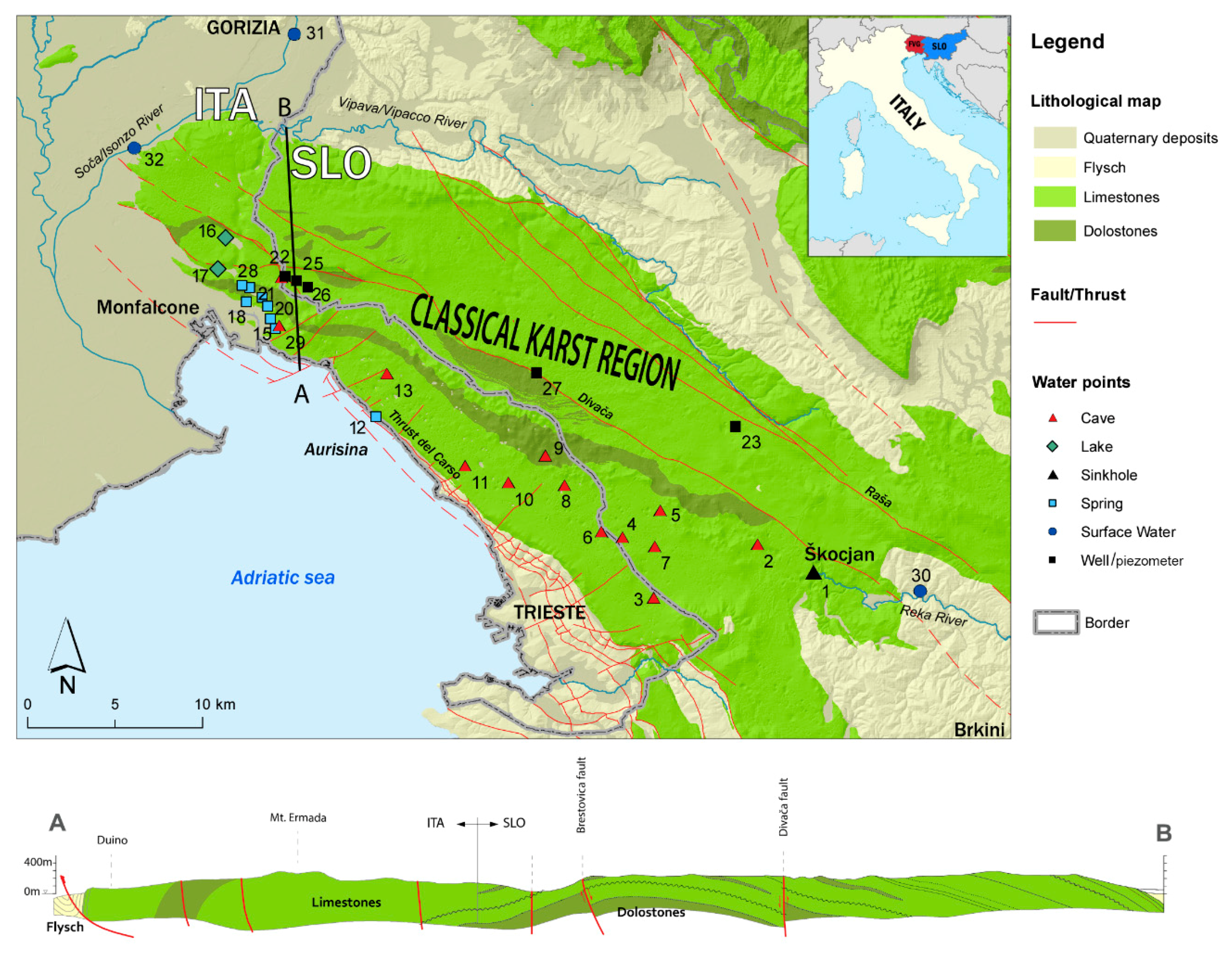


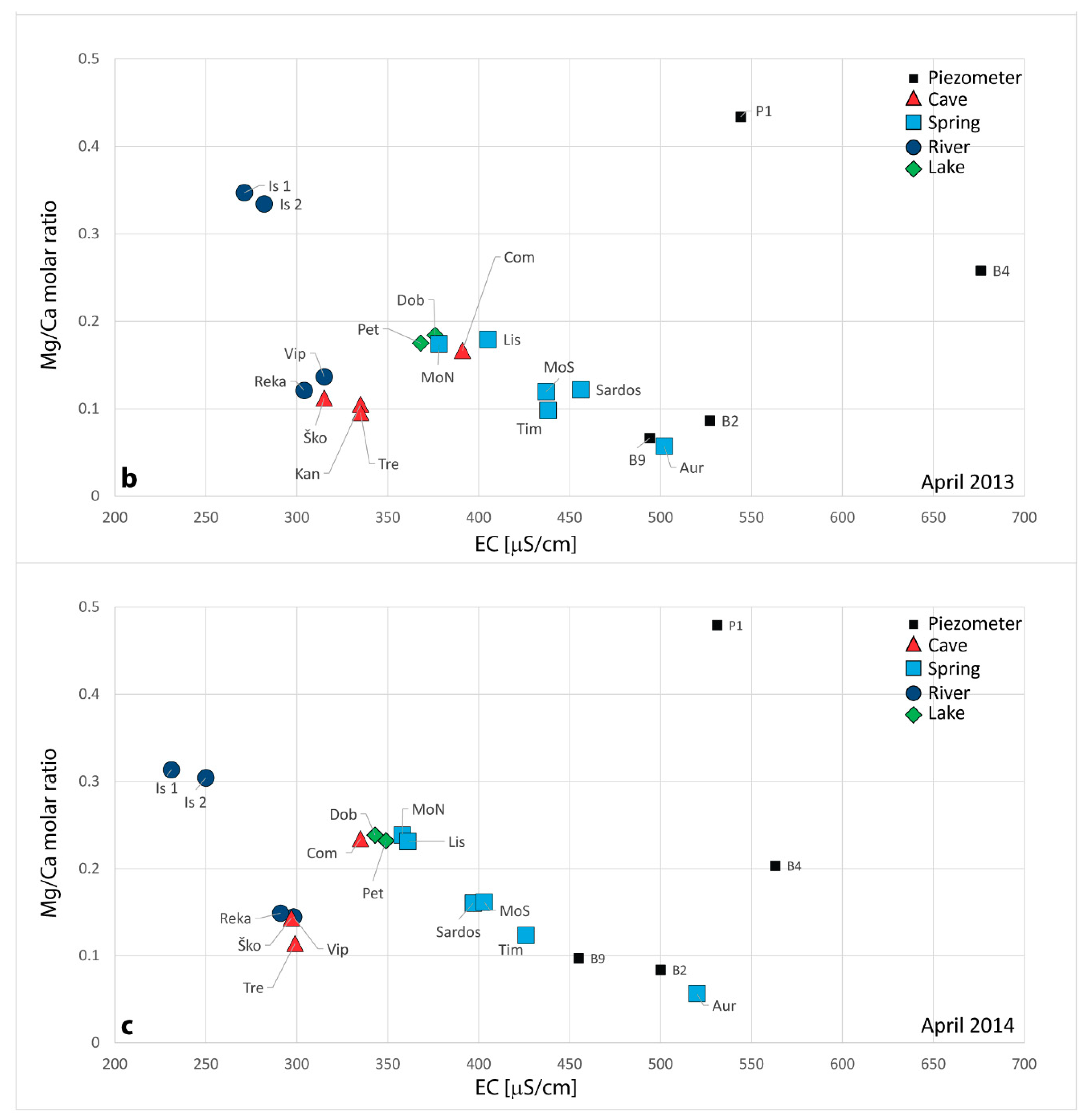
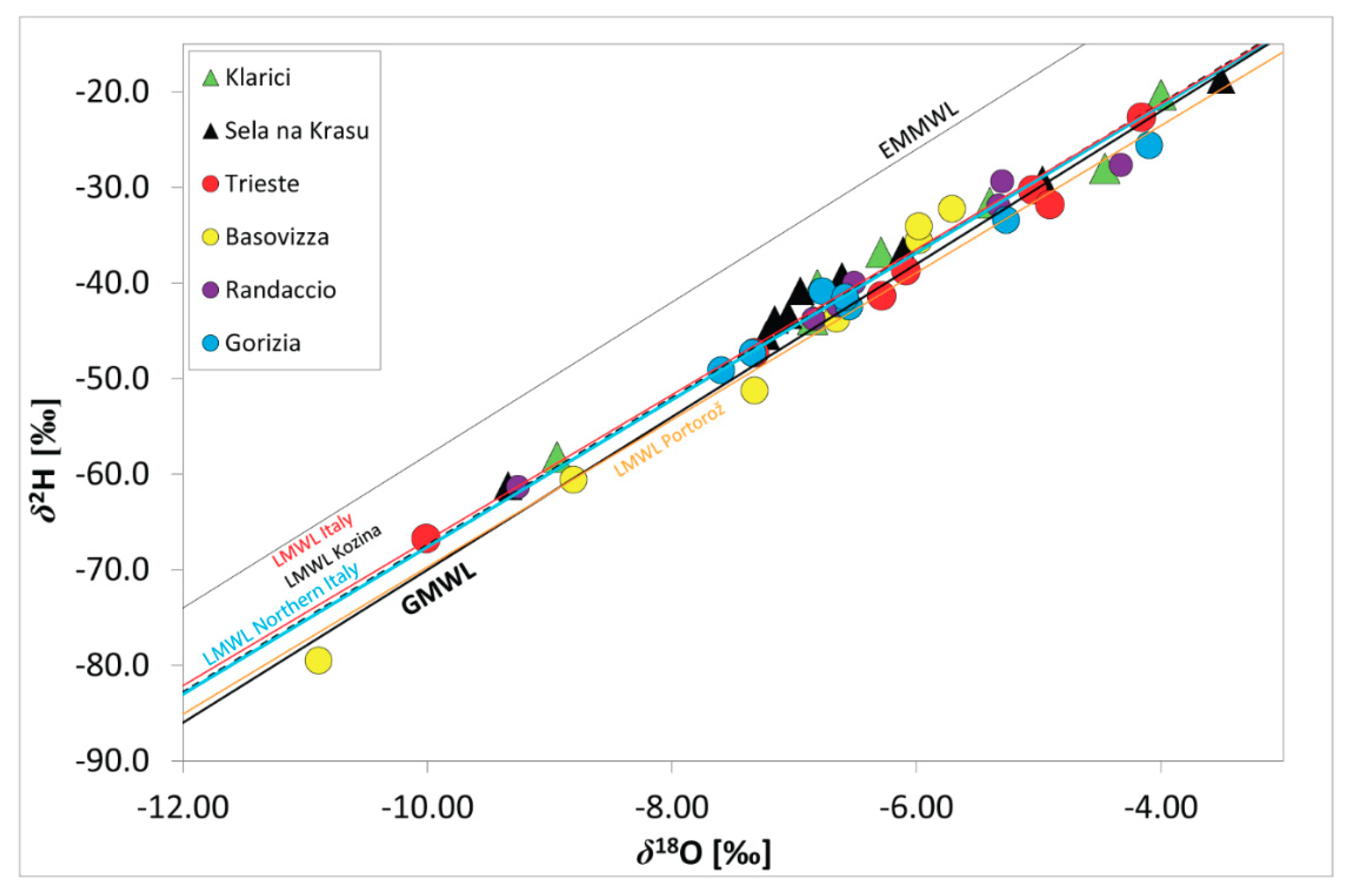
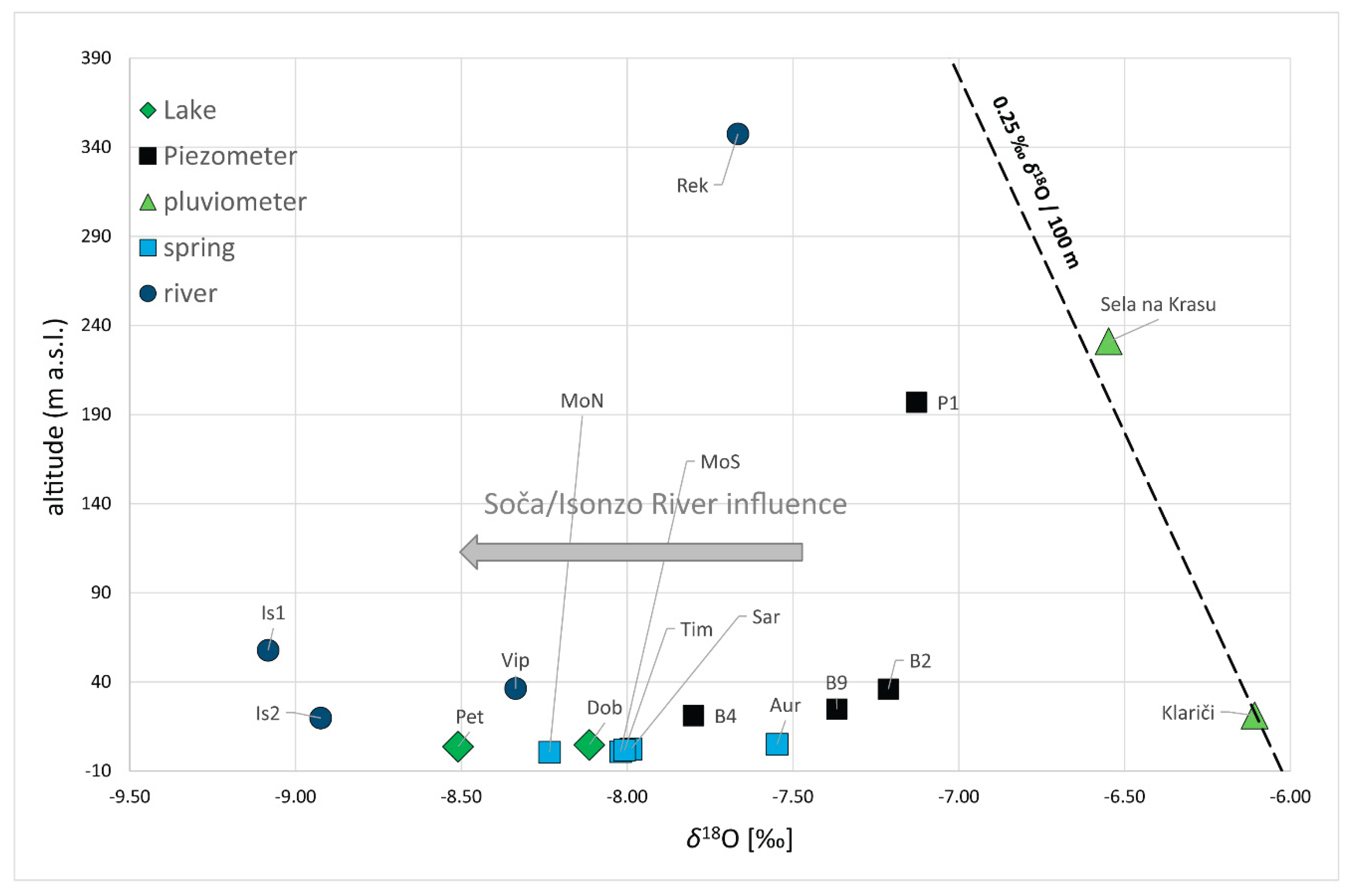
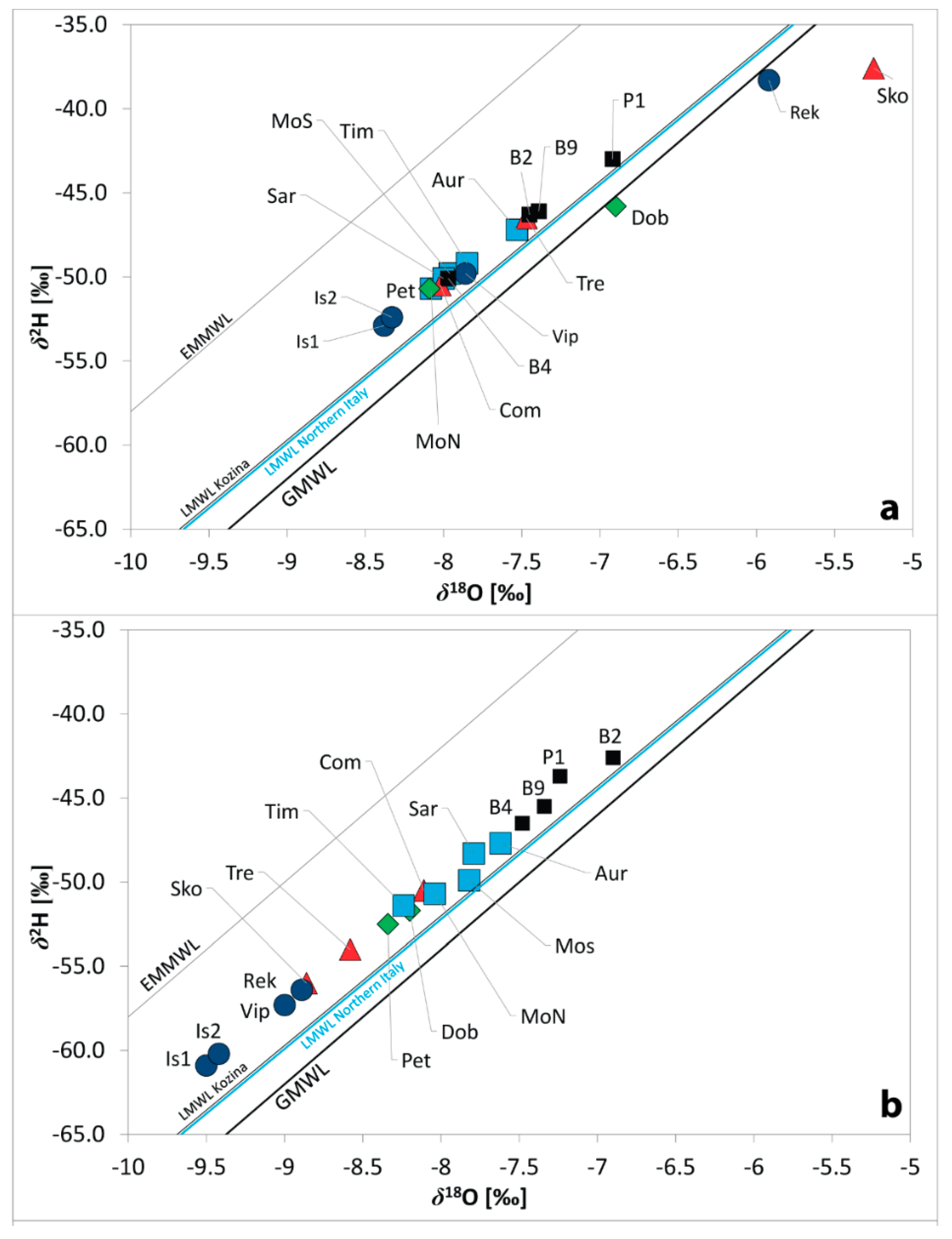
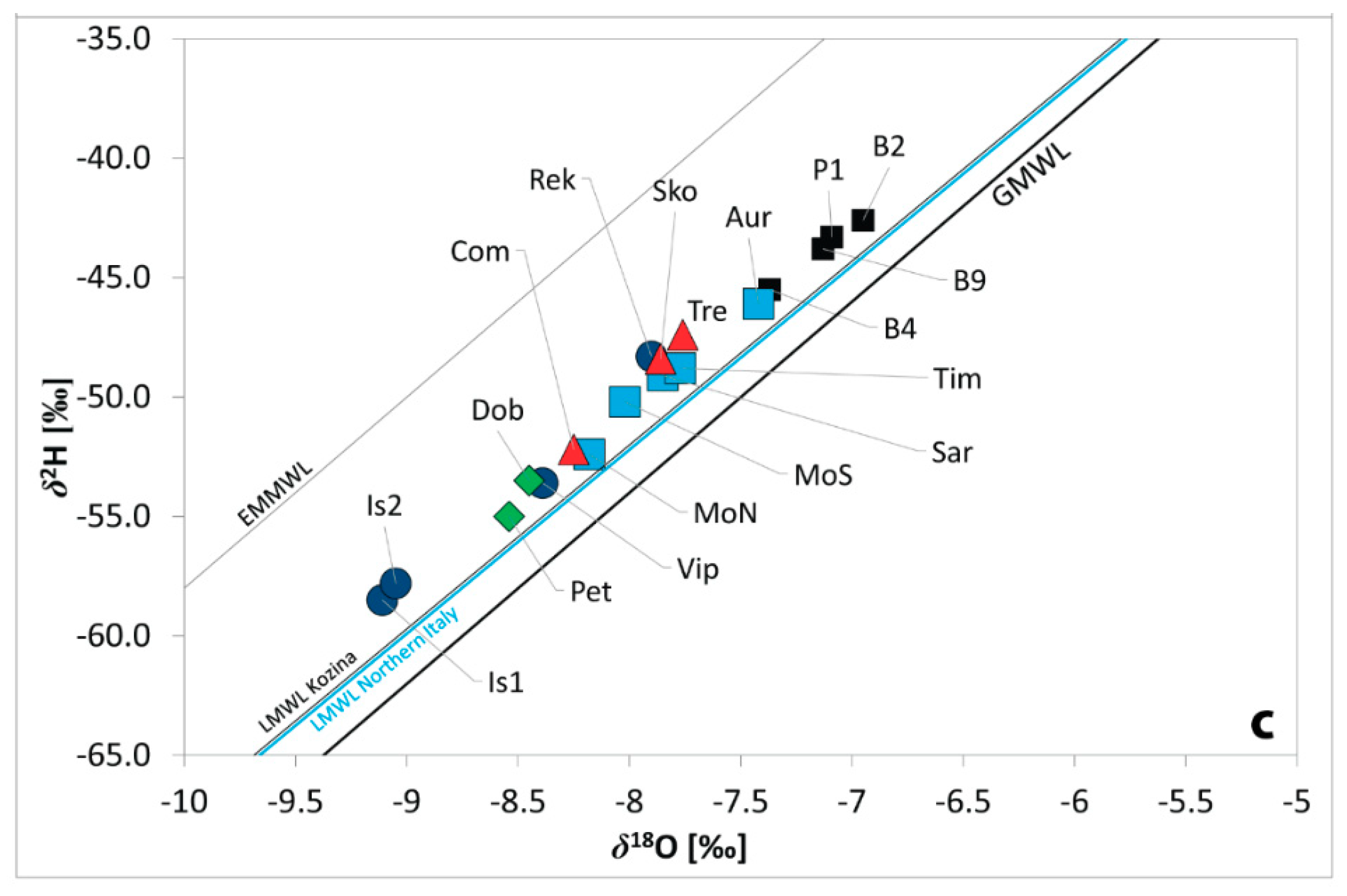
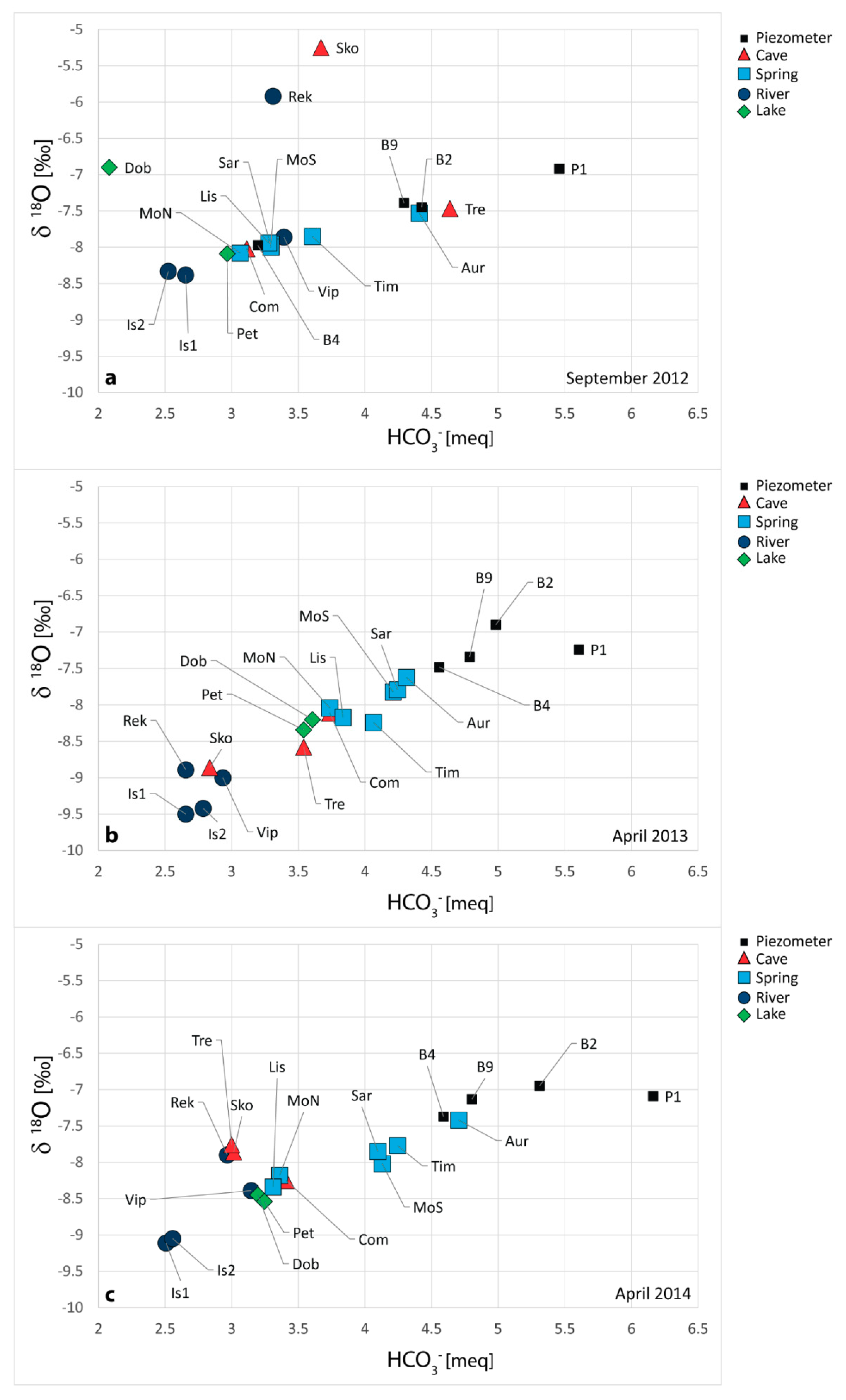
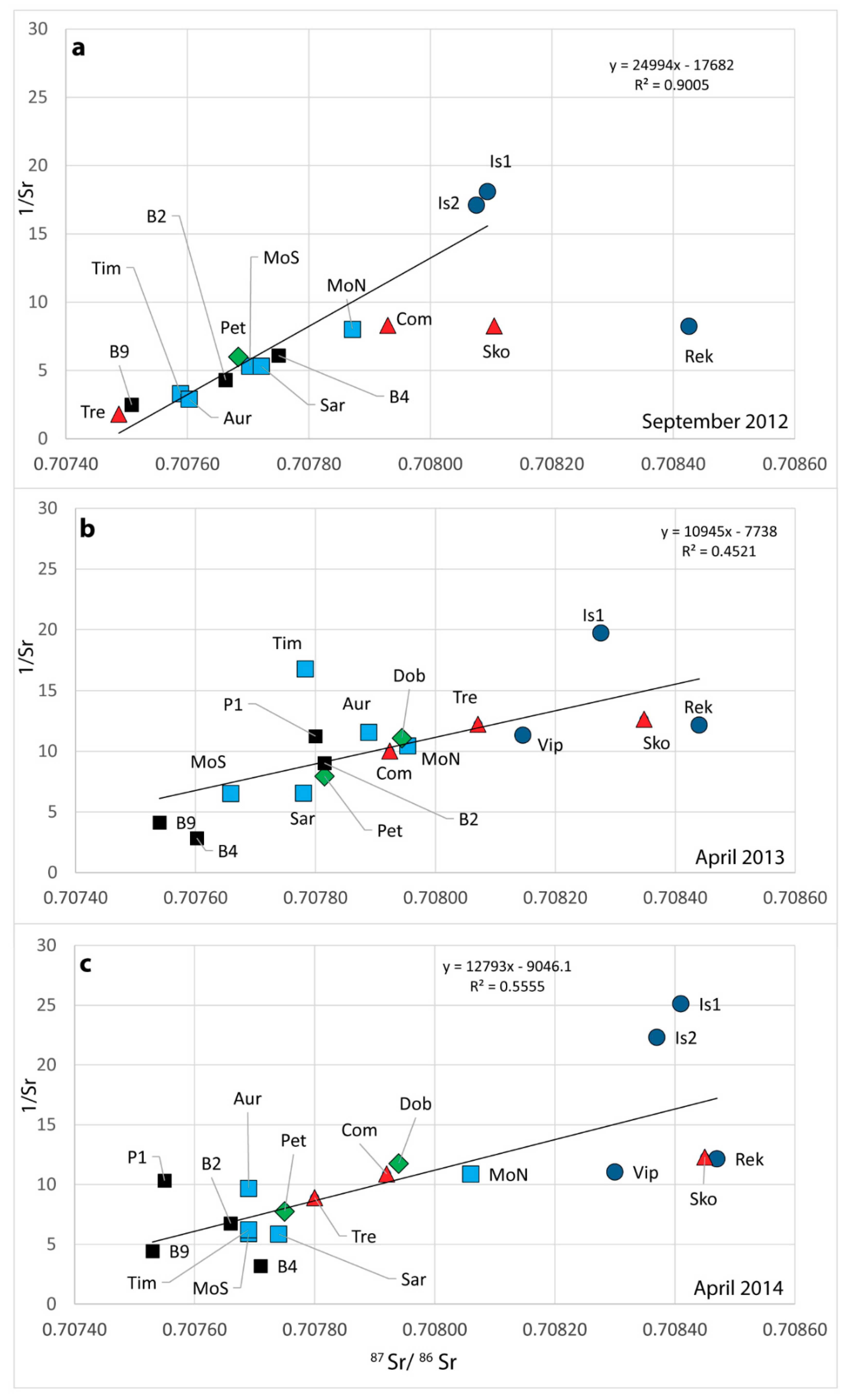
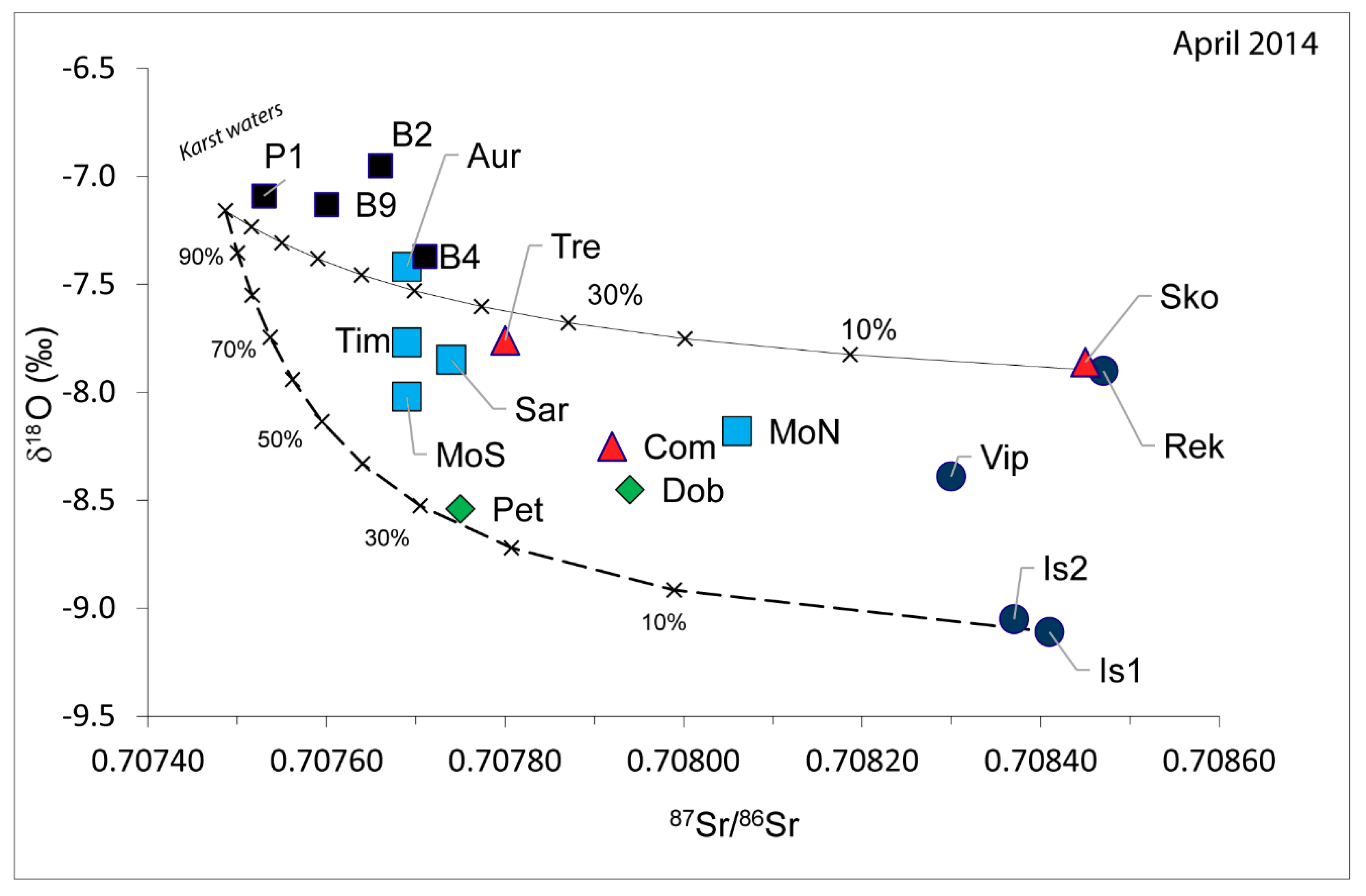

| ID | T (°C) | pH | EC (S/cm) | Ca2+ (mg/L) | Mg2+ (mg/L) | Na+ (mg/L) | K+ (mg/L) | HCO3− (mg/L) | SO42− (mg/L) | Cl− (mg/L) | NO3− (mg/L) | SiO2 (mg/L) |
|---|---|---|---|---|---|---|---|---|---|---|---|---|
| Water Cave | ||||||||||||
| Škocjanske jame (Sko) | 13.8 (8.1–21.9) | 8.0 (7.7–8.4) | 350 (297–407) | 63.1 (54.4–73.3) | 4.3 (3.7–4.9) | 3.4 (2.9–4.0) | 1.0 (0.5–1.6) | 201 (173–224) | 6.1 (2.7–8.0) | 4.3 (2.7–5.7) | 2.1 (0.0–5.3) | 2.8 (0.4–3.8) |
| Jama v Kanjaducah (Kan) | No data | 7.3 (7.2–7.5) | 437.3 (371–490) | 80.3 (69.1–87.9) | 4.6 (4.4–4.9) | 4.4 (3.5-5.4) | 0.8 (0.6–1.1) | 254 (214–282) | 8.2 (8.0–8.7) | 6.7 (5.0–8.4) | 4.8 (4.5–5.5) | 3.0 (2.0–4.7) |
| Abisso di Trebiciano (Tre) | 9.8 (8.0–12.0) | 7.3 (7.1–7.5) | 411.3 (326–494) | 78.2 (57.8–88.5) | 4.6 (4.0–5.4) | 5.5 (3.5–9.5) | 0.8 (0.7–1.3) | 244 (183–283) | 9.1 (8.1–10.2) | 7.8 (3.6–13.7) | 5.6 (3.9–7.3) | 4.0 (3.4–4.7) |
| Cavernetta di Comarie (Com) | 13.5 (6.1–20.2) | 7.5 (7.08–7.69) | 359 (326–392) | 58.7 (51.9–68.3) | 8.3 (6.9-8.8) | 3.3 (3.2–3.5) | 0.7 (0.6–0.8) | 206 (190–228) | 7.9 (7.0–8.9) | 4.3 (3.9–5.1) | 6.0 (4.2–7.2) | 2.6 (1.6–3.5) |
| River | ||||||||||||
| Soča/Isonzo 1 (Is1) | 15.3 (9.9–23) | 8.1 (7.25–8.3) | 261 (231–281) | 41.1 (40.0–41.8) | 8.7 (7.6–9.3) | 1.7 (1.3–1.9) | 0.5 (0.3–0.6) | 160 (153–162) | 6.6 (4.3–9.3) | 1.9 (1.2–2.9) | 2.4 (2.2–.7) | 1.2 (0.9–1.6) |
| Vipava/Vipacco (Vip) | 15.4 (6.2–26.3) | 8.3 (8.1–8.4) | 324 (298–352) | 57.1 (49.4–64.9) | 5.5 (4.7–6.1) | 4.3 (3.2–6.3) | 0.8 (0.6–1.0) | 193 (179–207) | 8.1 (7.1–10.6) | 4.3 (2.9–5.4) | 5.4 (3.6–8.4) | 1.8 (0.9–2.9) |
| Soča/Isonzo 2 (Is2) | 13.6 (5.3–21.2) | 8.4 (8.2–8.6) | 264 (250–282) | 42.2 (38.8–45.5) | 8.6 (7.6–9.3) | 1.8 (1.3–2.3) | 0.5 (0.3–0.5) | 162 (154–170) | 6.6 (4.6–9.5) | 2.1 (1.3–3.4) | 3.0 (2.1–4.2) | 1.2 (0.3–2.4) |
| Reka (Rek) | 11.6 (2.2–21.0) | 8.3 (8.0–8.6) | 327 (291–377) | 56.0 (51.6–61.1) | 5.2 (3.8–6.0) | 4.2 (3.0–6.4) | 1.2 (0.6–2.7) | 183 (162–202) | 9.7 (7.2–12.4) | 4.7 (2.7–7.0) | 4.0 (2.2–5.8) | 2.4 (1.0–3.5) |
| Well/Piezometer | ||||||||||||
| B2 | 499 (476–527) | 87.0 (62.1–102.2) | 6.6 (5.2–8.3) | 3.7 (2.6-4.8) | 0.7 (0.4–1.0) | 295 (270–324) | 8.1 (6.8–9.1) | 4.9 (2.7–6.6) | 7.4 (5.1–9.6) | 3.5 (2.7–3.9) | ||
| B9 | 15.1 (14.9–15.5) | 7.2 (7.1–7.4) | 471 (455–494) | 85.2 (77.4–92.0) | 6.0 (3.7–7.5) | 4.2 (2.9–5.3) | 0.5 (0.3–0.6) | 277 (261–293) | 7.7 (5.8–9.3) | 6.4 (4.3–8.2) | 4.9 (2.1–6.6) | 2.7 (1.5–3.4) |
| P1 | 12.8 (12.3–13.2) | 7.3 (7.2–7.3) | 547 (528–585) | 80.7 (75.3–86) | 23.4 (21–26.4) | 1.4 (1.4–1.5) | 0.2 (0.2–0.2) | 355 (333–376) | 6.4 (6.1–6.6) | 1.8 (1.7–2.0) | 2.0 (1.7–2.2) | 3.9 (3.4–4.6) |
| B4 | 13.9 (11.9–15.1) | 7.6 (7.5–7.9) | 520 (383–676) | 68.7 (53.2–82.7) | 10.5 (9.5–11.5) | 20.5 (8.1–32.1) | 1.1 (0.9–1.3) | 241 (1950–280) | 12.3 (9.6–14.7) | 37.3 (13.5–60) | 5.0 (2.5–6.5) | 2.9 (2.1–4.3) |
| Lake | ||||||||||||
| Doberdò (Dob) | 13.8 (10.1–13.6) | 7.6 (7.4–7.7) | 320 (234–376) | 52.4 (30.0–63.6) | 8.0 (7.1–8.8) | 2.8 (2.2–3.3) | 0.7 (0.6–0.8) | 188 (127–220) | 6.9 (4.8–8.0) | 3.6 (2.5–4.4) | 4.6 (0.0–6.9) | 2.5 (1.9–3.1) |
| Pietrarossa (Pet) | 13.7 (11.9–15.0) | 7.7 (7.5–7.8) | 338 (295–368) | 54.8 (49.0–65.0) | 8.1 (6.9–8.6) | 3.4 (3.1–3.7) | 0.6 (0.6–0.7) | 195 (181–216) | 7.6 (6.7–9.1) | 4.6 (4.0–5.6) | 4.6 (3.4–6.2) | 2.1 (1.3–2.5) |
| Spring | ||||||||||||
| Aurisina (Aur) | 12.5 (9.6–13.8) | 7.2 (7.0–7.5) | 492 (420–520) | 91.5 (85.6–98.3) | 4.2 (3.1–6.0) | 8.5 (6.7–10.9) | 1.1 (0.9–1.5) | 274 (263–287) | 11.4 (9.6–13.3) | 14.0 (10.6–18.2) | 10.4 (9.0–11.9) | 2.9 (0.3–4.1) |
| Timavo (Tim) | 12.2 (8.2–15.4) | 7.4 (7.3–7.5) | 420 (364–459) | 75.4 (64.7–81.2) | 6.7 (4.7–8.6) | 5.0 (4.2–5.7) | 0.7 (0.5–0.9) | 244 (220–259) | 8.5 (7.2–11.0) | 7.9 (5.9–10.3) | 6.1 (5.7–6.6) | 3.2 (2.3–4.2) |
| Sardos (Sar) | 13.3 (10.5–15.4) | 7.4 (7.1–7.5) | 404 (345–458) | 69.0 (55.6–81.1) | 8.1 (6.0–9.3) | 5.0 (4.4–6.7) | 0.7 (0.6–0.9) | 223 (166–259) | 8.5 (7.4–9.5) | 7.7 (6.0–11.6) | 6.2 (5.1–7.5) | 2.7 (1.8–4.0) |
| Moschenizze N (MoN) | 12.6 (10.4–14.1) | 7.7 (7.4–7.6) | 355 (304–385) | 58.2 (50.9–69.0) | 8.4 (7.3–8.8) | 3.7 (3.1–4.9) | 0.7 (0.6–0.8) | 204 (187–228) | 7.8 (7.0–8.9) | 5.5 (4.0–8.7) | 5.8 (4.1–6.9) | 2.2 (1.2–3.2) |
| Moschenizze S (MoS) | 13.1 (10.3–15.1) | 7.5 (7.2–7.7) | 407 (345–459) | 70.0 (55.9–84.1) | 8.0 (6.1–9.3) | 5.2 (4.4–7.3) | 0.7 (0.6–0.9) | 234 (201–257) | 8.5 (7.5–9.5) | 8.2 (6.1–12.6) | 6.1 (5.1–7.3) | 2.7 (1.4–4.1) |
| ID | δ18O (‰) | δ2H (‰) | d-Excess (‰) | 87Sr/86Sr | Sr (μg/L) |
|---|---|---|---|---|---|
| Water cave | |||||
| Škocjanske jame (Sko) | −5.25 | −37.6 | 4.4 | 0.708105 | 98.3 (79.1–120.9) |
| −8.86 | −56.0 | 14.9 | 0.708450 | ||
| Jama v Kanjaducah (Kan) | −7.40 | −46.0 | 13.2 | 0.707580 | 316.4 (273.7–359.1) |
| −8.41 | −52.3 | 15.0 | 0.708012 | ||
| Abisso di Trebiciano (Tre) | −7.47 | −46.3 | 13.3 | 0.707487 | 238.9 (81.8–552.4) |
| −8.58 | −54.0 | 15.5 | 0.708071 | ||
| Cavernetta di Comarie (Com) | −8.02 | −50.5 | 13.7 | 0.707738 | 104.5 (91.5–120.2) |
| −8.95 | −55.9 | 15.7 | 0.707930 | ||
| River | |||||
| Soča/Isonzo 1 (Is1) | −8.38 | −52.9 | 14.1 | 0.708094 | 50.1 (39.8–55.4) |
| −9.50 | −60.9 | 15.7 | 0.708700 | ||
| Vipava/Vipacco (Vip) | −7.86 | −49.0 | 13.1 | 0.707596 | 124.8 (88.2–214.4) |
| −9.00 | −57.3 | 14.7 | 0.708300 | ||
| Soča/Isonzo 2 (Is2) | −8.33 | −52.4 | 14.2 | 0.708076 | 46.8 (11.5–63.9) |
| −9.42 | −60.2 | 15.7 | 0.708370 | ||
| Reka (Rek) | −5.92 | −38.3 | 9.1 | 0.708295 | 93.6 (82.2–121.5) |
| −8.89 | −56.4 | 14.9 | 0.708530 | ||
| Well/Piezometer | |||||
| B2 | −6.90 | −42.6 | 12.6 | 0.707508 | 171.4 (110.8–231.6) |
| −7.55 | −46.5 | 13.9 | 0.707815 | ||
| B9 | −7.13 | −43.8 | 13.0 | 0.707508 | 278.9 (225.1–406.3) |
| −7.61 | −46.1 | 15.0 | 0.707540 | ||
| P1 | −6.92 | −42.8 | 12.4 | 0.707362 | 82.2 (17.2–125.9) |
| −7.26 | −43.7 | 15.3 | 0.707800 | ||
| B4 | −7.37 | −45.5 | 13.3 | 0.707602 | 265.1 (164.3–351.8) |
| −8.62 | −53.7 | 15.3 | 0.707910 | ||
| Lake | |||||
| Doberdò (Dob) | −6.90 | −45.8 | 9.4 | 0.707925 | 86.2 (54.7–101.1) |
| −8.88 | −54.5 | 16.5 | 0.708530 | ||
| Pietrarossa (Pet) | −8.09 | −50.7 | 13.3 | 0.707684 | 135.4 (119.7–167.2) |
| −9.05 | −57.5 | 14.9 | 0.707815 | ||
| Spring | |||||
| Aurisina (Aur) | −7.18 | −43.7 | 13.0 | 0.707603 | 165.1 (86.5–341.8) |
| −7.99 | −49.3 | 14.6 | 0.708190 | ||
| Timavo (Tim) | −7.62 | −46.8 | 14.4 | 0.707589 | 192.4 (59.6–299.6) |
| −8.56 | −52.3 | 16.2 | 0.708210 | ||
| Sardos (Sar) | −7.67 | −48.3 | 13.0 | 0.707695 | 191.9 (152.7–227.8) |
| −8.63 | −52.6 | 16.4 | 0.707840 | ||
| Moschenizze North (MoN) | −8.02 | −49.7 | 13.0 | 0.707872 | 105.4 (92.0–124.8) |
| −8.85 | −55.6 | 15.2 | 0.708670 | ||
| Moschenizze South (MoS) | −7.65 | −47.0 | 12.7 | 0.707659 | 187.1 (153.4–214.0) |
| −8.64 | −52.9 | 16.2 | 0.707725 | ||
| Pluviometer | |||||
| Sela na Krasu | −3.51 | −18.7 | 9.4 | No data | No data |
| −9.34 | −61.2 | 14.8 | No data | ||
| Klariči | −4.00 | −20.3 | 7.7 | No data | No data |
| −8.94 | −58.2 | 14.3 | No data | ||
| Filzi (Trieste) | −4.16 | −22.7 | 7.5 | No data | No data |
| −10.01 | −66.7 | 13.3 | No data | ||
| Basovizza | −5.71 | −32.2 | 7.3 | No data | No data |
| −10.89 | −79.5 | 13.8 | No data | ||
| Randaccio | −4.33 | −27.6 | 7.0 | No data | No data |
| −9.26 | −61.3 | 13.0 | No data | ||
| Gorizia | −4.10 | −25.6 | 7.2 | No data | No data |
| −7.60 | −49.1 | 13.3 | No data | ||
© 2018 by the authors. Licensee MDPI, Basel, Switzerland. This article is an open access article distributed under the terms and conditions of the Creative Commons Attribution (CC BY) license (http://creativecommons.org/licenses/by/4.0/).
Share and Cite
Calligaris, C.; Mezga, K.; Slejko, F.F.; Urbanc, J.; Zini, L. Groundwater Characterization by Means of Conservative (δ18O and δ2H) and Non-Conservative (87Sr/86Sr) Isotopic Values: The Classical Karst Region Aquifer Case (Italy–Slovenia). Geosciences 2018, 8, 321. https://doi.org/10.3390/geosciences8090321
Calligaris C, Mezga K, Slejko FF, Urbanc J, Zini L. Groundwater Characterization by Means of Conservative (δ18O and δ2H) and Non-Conservative (87Sr/86Sr) Isotopic Values: The Classical Karst Region Aquifer Case (Italy–Slovenia). Geosciences. 2018; 8(9):321. https://doi.org/10.3390/geosciences8090321
Chicago/Turabian StyleCalligaris, Chiara, Kim Mezga, Francesca Federica Slejko, Janko Urbanc, and Luca Zini. 2018. "Groundwater Characterization by Means of Conservative (δ18O and δ2H) and Non-Conservative (87Sr/86Sr) Isotopic Values: The Classical Karst Region Aquifer Case (Italy–Slovenia)" Geosciences 8, no. 9: 321. https://doi.org/10.3390/geosciences8090321






